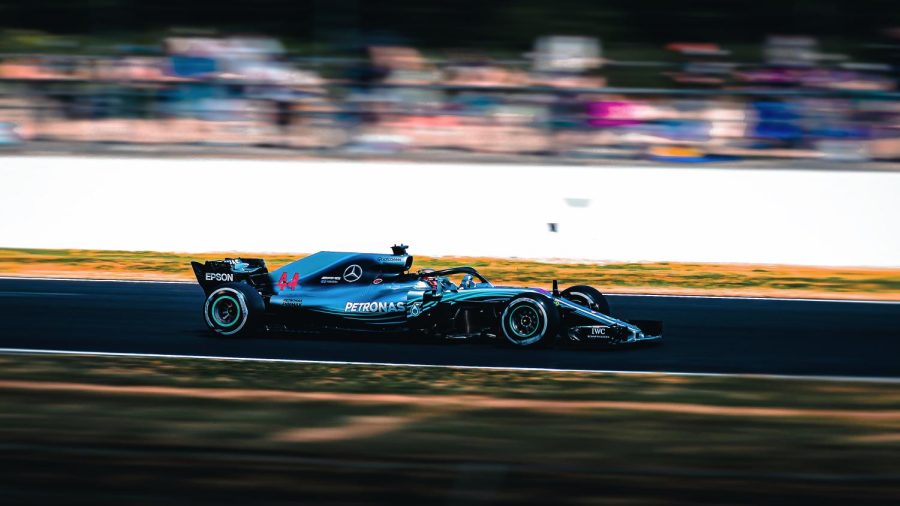Formula 1 2023 Season Preview and Sustainability Strategy
May 10, 2023
Although not as popular as the Indy 500 or NASCAR here in the States, Formula 1 is one of the largest and most popular sports in the world. I’m sure many of you may not have the slightest clue what Formula 1 is, so we at Viking will explain.
To compare Formula 1 to a more simple sport, think of it at a track race- except in cars that can move up to 400 kilometers per hour, or 250 miles per hour, which generate G-Force equivalent to the planes of stunt flyers. Within Formula 1, there are 10 teams, each with two racers. Known as the best 20 racers on the planet, Formula 1 drivers are at the pinnacle of speed and skill, and work with the world’s greatest engineers to create the most technologically advanced cars in history. Races are held all around the world, including both historical circuits and some brand-new, never-driven-before tracks. Races last about 90 minutes, each lap averaging about a minute and a half. Each track is different so lap times and strategies are vastly different from circuit to circuit.
The 2023 Formula 1 season consists of 23 races, each race granting points to the drivers who finish in the top ten. Points are awarded as follows: 25 points to the winner, 18 points to the second-place finisher, 15 points to the third-place, and all the way to the 10th who is awarded one point. Another point is awarded to the driver with the fastest lap, but only if they finish in the top 10.
Formula 1 is as much or even more a team sport as an individual sport. In the sport, it is equally or arguably even more important to place well in the individual championship with points won during the season as it is for your team to place well.
The last decade has been dominated by Mercedes driver Lewis Hamilton, winning the championship from 2014-2020 with the exception of 2016 when his teammate Nico Rothburg won 2016. His run, however, has been halted by a new star, who emerged in 2016 for Red Bulls racing team. The Dutch driver Max Verstappen has finished on top the last two seasons and is continuing his reign into the 2023 season winning the first race in Bahrain. You can also guess that during Hamilton’s reign, his team was leading the constructor’s championship, and you would be right, as they won from 2014 to 2021. Only recently has there been a different team winning the constructors championship, that being Red Bull Racing in 2022.
“I think the title fight will be between Red Bull and Aston Martin this year,” Schrage said. “I would not be surprised if Max Verstappen were to win his third championship this year.”
Unfortunately, many of the international Formula 1 races are early in the morning due to the time shift. You can watch on ESPN here in the US, or you can buy F1TV for $10 a month or $80 for a whole season. This grants you access to driver cams, live timing results, and even listening to the team radios. Whether you are looking to become a Formula 1 casual or a diehard Haas fan, The F1TV package is well worth the money as it gives you countless features to elevate your experience watching Formula 1, and would definitely make it a lot easier to understand if you’re just getting into it.
I would not be surprised if Max Verstappen were to win his third championship this year
— Max Schrage
The races themselves are hard to grasp as newcomers, so here is an oversimplification of what a typical Formula 1 race looks like.
Qualifying:
Formula 1 qualifying is reasonably complex, and not easy to understand your first time watching. Qualifying starts with an 18-minute Q1, where drivers are not racing against each other, but rather against the clock. There are no placements, just times, and at the end of the 18 minutes the bottom five drivers with the slowest times are eliminated. The bottom five placements are then solidified. Qualifying then goes into Q2, which is 15 minutes long and does the same as Q1 except with places 11-15. A Q3 is then raced which is 12 minutes long and will determine the starting 10 of the grid. The driver with the fastest time gets placed at the front of the grid, in what is known as the pole position. This would mean the driver would have to drive a top 15 lap, followed by a top 10 lap time, then finish first in Q3. There are no points in qualifying, but getting a strong starting position is essential to a driver’s performance in the actual race.
Sprint:
In the rarity that there is a sprint race before the actual race, qualifying only determines the sprint start, and the results of the sprint race determine the start of the actual race. The sprint is raced on the same track as the race would be held but will be much shorter with about a third of the laps. This means drivers take more risk, and unlike a typical race, there are no scheduled pit stops. 8 points are awarded to the winner of the sprint, with each place getting one point less than the previous place.
Race Day:
You never want to miss David Croft’s iconic line, Lights out and away we go, at the beginning of each race, as the start is usually the most eventful and exciting part of the race. With all drivers lined up in two tight columns of 10 when the lights go out, there is usually a lot of action. With 10 rows of cars going head to head, there are intense overtakes, cars going bumper to bumper to fight for positions, and even the occasional multi-car crash. The race lasts up to two hours, either finishing at the two-hour mark or if they reach the max threshold of laps, which is typically in the 50 to 70-lap range. Each race is packed with endless amounts of risk-taking and calculating, which will keep you on the edge of your seat. Of course, you can never miss the end of the race, which can be packed with the closest matchups––take the Abu Dhabi Grand Prix ending for example.
Ways to watch:
Unfortunately, many of the international Formula 1 races are early in the morning due to the time shift. You can watch on ESPN here in the US, or you can buy F1TV for $10 a month or $80 for a whole season. This grants you access to driver cams, live timing results, and even listening to the team radios. Whether you are looking to become a Formula 1 casual or a diehard Haas fan, The F1TV package is well worth the money as it gives you countless features to elevate your experience watching Formula 1, and would definitely make it a lot easier to understand if you’re just getting into it.
Sustainability 2030
Recently, in 2019, Formula 1 vowed to be completely reliant on renewable energy in the year 2030, with the goal of having a net zero environmental impact. Apart from popular belief, only 0.7% of the emissions that Formula 1 produces come directly from the emissions the cars produce. Many bash the International Automobile Federation (FIA), the federation which oversees Formula 1, for having cars that run on practically the equivalent of jet fuel, which––as you could guess––is not the greenest source of energy, but the roots of their carbon footprint troubles exist elsewhere.
It seems like a daunting task to reduce admissions from 256,000 to zero in such a short time period but they seem very determined to do so
— Max Schrage
According to Formula 1, they produce an average of 256,000 tonnes of CO2 each year. They also state that 73% of their emissions come from the logistics of setting up and moving race setups at their 23 tracks all across the world. Their sustainability strategy published in 2019 contains a commitment to a net zero impact on the environment, which means there needs to be a lot to change in not all that much time.
“It seems like a daunting task to reduce admissions from 256,000 to zero in such a short time period but they seem very determined to do so,” Max Schrage (‘23) said. “I am most definitely intrigued to see how they put their plan into action.”
Their plan for the year 2030 consists of a net zero emission produced by the actual cars on the track. Formula 1 also looks to invest in more efficient low-carbon travel arrangements for the upcoming season, as well as 100% renewably powered facilities and factories. Lastly, in their efforts to completely eliminate their carbon emissions globally by 2030, they plan to create CO2 sequestration programs.
With a lofty goal in mind, many speculate whether Formula 1 will be able to fulfill its vows of sustainability.
“While the push for sustainability in formula one involving their carbon neutral initiative is admirable, their actions so far seem rather performative, as they still travel thousands of miles around the globe per year for races, which could be cut down significantly by a more efficient race schedule,” Cameron Phillips (‘23) said.
While the push for sustainability in formula one involving their carbon neutral initiative is admirable, their actions so far seem rather performative, as they still travel thousands of miles around the globe per year for races, which could be cut down significantly by a more efficient race schedule
— Cameron Phillips
While there is still time for the FIA and Formula 1 to erase their emissions from the planet in an admirable attempt to be net zero, the racing community hopes to see the sport make strides from a notoriously environmentally antagonistic to a more sustainable and eco-friendly sport.
“I think that F1s movement to become fully carbon neutral by 2030 is exciting and could pave the way for other corporations to follow in their path,” Schrage said.








susan reed • May 12, 2023 at 7:17 am
Great article covering the basics of F1.
Ivan Ijzerman • May 15, 2023 at 3:29 pm
Thanks Susan!